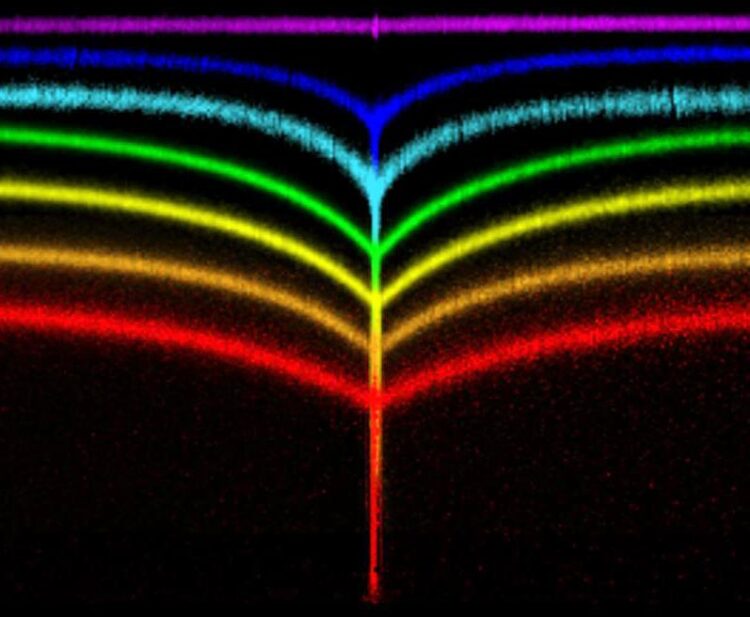The memory of folds

Folding of a soft material leaves behind a scar which serves as a nucleation point for subsequent folds
(c) Stefan Karpitschka
What happens when soft materials are compressed strongly? Researchers from the Max Planck Institute for Dynamic and Self-Organization, the University of Twente and Cornell University now revealed the morphology of creases created upon folding at micrometer scale. They revealed a dual folding mechanism driven by capillary forces, similar to wetting liquids, causing a T-shape folding profile. The unfolding leaves behind a scar which serves as a nucleation point for subsequent folds. Without damaging the material, it thereby enables a freely programmable folding memory of soft surfaces.
The principle of folding is part of our everyday lives: When closing your hand or bending your arm, a crease is formed, causing the skin to make self-contact which is reversed upon reverting the movement. On a microscopic scale, such folding is known to leave behind small scars which serve as initiation points for subsequent folds. Stefan Karpitschka, principal researcher of the study investigating such folds, explains: “So far, these scars have been considered to result from the reduction of surface tension that leads to adhesion if a soft surface contacts itself. We demonstrate that surface tension also plays an important role for the micro-morphology of creases, and that its reduction is not sufficient to explain the origin of the scars.”
Capillarity induces T-shapes folding profiles
To observe the behavior of solid materials upon folding, the researchers used a polymer gel which could be compressed in a defined manner. A layer of fluorescent probes at the surface of this gel enabled them to follow the crease formation on microscopic scale. Without surface tension, the material folded in a V-shaped profile. However, if the surface tension comes into plan, the balance of surface forces changes the morphology: At the upper edge of the self-contacted material a second fold emerges which overall results in a T-shaped profile of the crease.
Furthermore, this also induces a strong curvature of the free surface which defines the capillarity forces at the crease. “It has been observed previously that capillarity effects cannot only be observed in liquids, but are also found in soft solid materials” explains Karpitschka. “Here we illustrate that also surface contacts of solid materials show a capillary nature. This is the physical explanation for both the surface curvature and the T-shaped profile of the crease.”
Pre-defining folds by contact line pinning
Overall, these observations show that emerging scars in materials on the microscale are caused by pinning of the contact line upon unfolding the material. These scars therefore do not indicate a damage of the material but constitute the remains of self-adhesion after a fold. This causes an asymmetry in the folding and unfolding of materials, and defines the occurrence sites of subsequent creases.
“Our observations on crease morphology open a new route to quantify the mechanics on solid-solid interfaces” concludes Karpitschka. “Such a ‘folding memory’ might play an essential role in the formation of subcellular structures in biology, but also in the microscale manufacturing oft soft robotics or smart textiles.”
Originalpublikation:
Pinning-Induced Folding-Unfolding Asymmetry in Adhesive Creases
Phys. Rev. Lett. 127, 028001 – Published 9 July 2021
https://doi.org/10.1103/PhysRevLett.127.028001
Weitere Informationen:
https://journals.aps.org/prl/abstract/10.1103/PhysRevLett.127.028001
Media Contact
All latest news from the category: Materials Sciences
Materials management deals with the research, development, manufacturing and processing of raw and industrial materials. Key aspects here are biological and medical issues, which play an increasingly important role in this field.
innovations-report offers in-depth articles related to the development and application of materials and the structure and properties of new materials.
Newest articles

Innovative 3D printed scaffolds offer new hope for bone healing
Researchers at the Institute for Bioengineering of Catalonia have developed novel 3D printed PLA-CaP scaffolds that promote blood vessel formation, ensuring better healing and regeneration of bone tissue. Bone is…

The surprising role of gut infection in Alzheimer’s disease
ASU- and Banner Alzheimer’s Institute-led study implicates link between a common virus and the disease, which travels from the gut to the brain and may be a target for antiviral…

Molecular gardening: New enzymes discovered for protein modification pruning
How deubiquitinases USP53 and USP54 cleave long polyubiquitin chains and how the former is linked to liver disease in children. Deubiquitinases (DUBs) are enzymes used by cells to trim protein…



